Meiji Jingu, Tokyo
Meiji Jingu (明治神宮) is the most famous Shinto shrine in Tokyo. It is located a stone's throw from
Harajuku station. The shrine is surrounded by a large forest, which together with the adjacent Yoyogi Park forms a huge green lung in the heart of Tokyo. It is worth visiting this place not only for its religious buildings, but also for walking in the sacred forest, immersed in a magical and spiritual atmosphere.
Things to see and things to do at Meiji Jingu
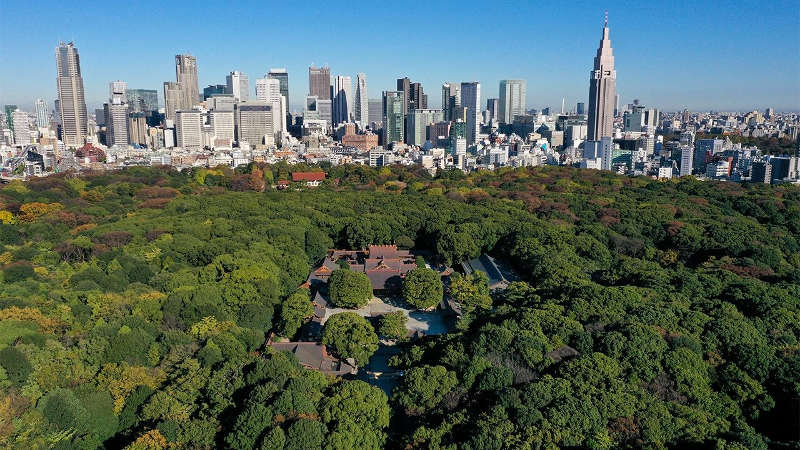 view from above of the Meiji Jingu forest, with Shinjuku's skyscrapers in the background
view from above of the Meiji Jingu forest, with Shinjuku's skyscrapers in the background
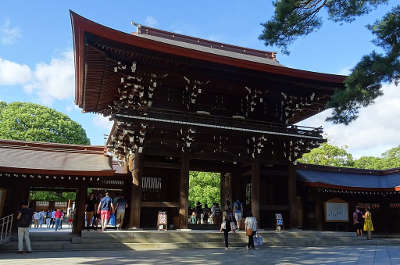
Meiji Jingu Shrine
(free admission, open from sunrise to sunset)
Meiji Shrine is a Shinto shrine dedicated to the spirits of Emperor Meiji (1852-1912) and his consort, Empress Shoken (1849-1914). The shrine was inaugurated and consecrated in 1920, eight years after the death of the emperor. This emperor was the first of modern Japan: ascended to the throne in 1867, during the Meiji period Japan opened up to the West and modernized itself becoming one of the major world powers. Destroyed during the Second World War, the current buildings of the shrine were rebuilt in 1958. To reach these buildings, you have to walk about 10 minutes along a path that crosses the surrounding forest. The entrances to the sacred area are marked by huge torii gates. It is one of the most popular shrines in Tokyo, not only among tourists, but also for New Year celebrations (hatsumode) and as a place to celebrate traditional weddings. It is not uncommon to see more than one wedding taking place at the same time, the celebrations are held both in the morning and in the afternoon.
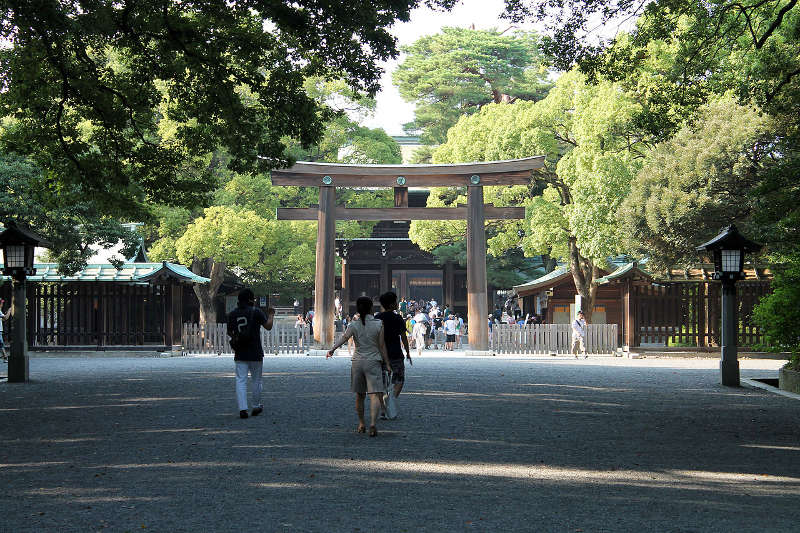 approaching Meiji Jingu Shrine
approaching Meiji Jingu Shrine
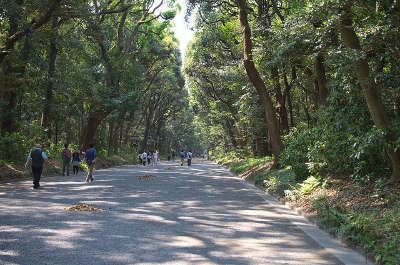
Meiji Jingu Forest
(free admission, open from sunrise to sunset)
The sacred forest surrounding the buildings of Meiji Jingu Shrine may seem natural at first glance, but in reality it is the fruit of human ingenuity. The "Shrine Forest" project, launched in 1915 following the death of Emperor Meiji, required the forest to mature naturally, without further human intervention, in four phases of 50 years each. Since the forest is considered sacred, there has been no human intervention since it was created, nothing has been added or taken away and when a tree falls, it is left as it is, to return to the ground. Today, more than a hundred years after the beginning of the initial sowing, the eternal forest is in its third phase, it covers 700,000 square meters, and it seems that everything is going as planned by its creators. It is one of the most iconic and popular green oases in Tokyo and it is a pleasure to get lost in its meanders to escape from the modernity and frenzy of the surrounding metropolis.
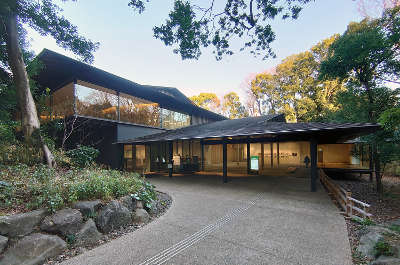
Meiji Jingu Museum
(admission 1000¥, opening hours 10:00-16:30, closed on thursday)
This museum is located about 200 meters from the Meiji Jingu grounds entrance on the Harajuku side. The building, partly made of wood, was designed by the famous architect Kuma Kengo and was inaugurated in 2019. The museum displays the treasures kept by the shrine and objects related to Emperor Meiji and the Empress Shoken.
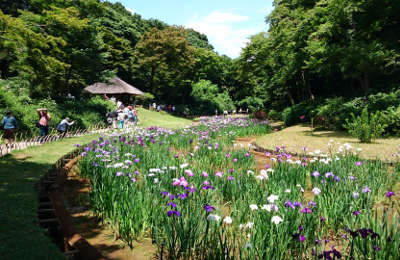
Meiji Jingu inner garden
Few visitors notice the presence of this small traditional garden in the southern part of the Meiji Jingu forest (the entrance is on the left, about 300 meters from the entrance on the Harajuku side). The garden was built in the early Edo period (1603-1867), so long before the famous shrine. Inside there is an iris garden (flowering in June), an azalea garden (flowering in spring), and many maples and other trees that turn red in autumn. Another symbolic place is the Kiyomasa well, from which flows the water that irrigates the gardens and feeds the garden pond. Overlooking the pond is the Kakuun-tei, a tea house built at the behest of Emperor Meiji as a place of relaxation for Empress Shoken.
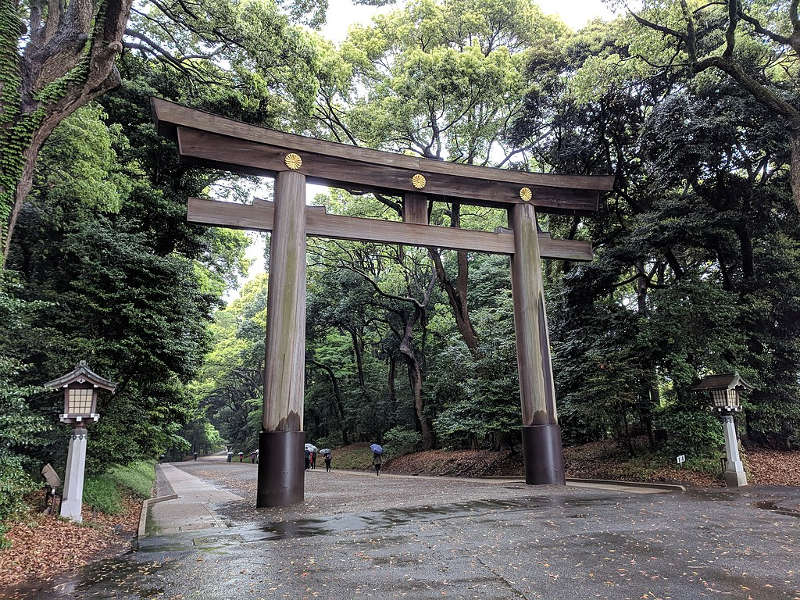 the torii gate to the sacred area of Meiji Jingu (Harajuku side)
the torii gate to the sacred area of Meiji Jingu (Harajuku side)
Other places inside Meiji Jingu
Next to the museum there is Forest Terrace, a building that houses a souvenir shop, a cafe and a restaurant. In the northern part of the forest there is the Shiseikan complex, a gym where kyudo (Japanese archery), judo, kendo and aikido are practiced.
How to get to Meiji Jingu
There are a total of three entrances to the sacred area of Meiji Jingu (see map). The main entrance and most used by tourists is located on the south side, just in front of the
west exit of
Harajuku station. Another entrance is to the north, near the
Kita-sando metro station. A third entrance is located to the north-west, near the
Sangūbashi railway station.
Map of Meiji Jingu, Tokyo
Guided tours, activities and other things to do
If you are planning a trip to Japan and you want to do something more than just visiting famous places and monuments, we suggest you to use
Rakuten Travel Experiences.
How to use Rakuten Travel Experiences
Rakuten Travel is a very useful website to
enrich your travel experience, especially if you are going solo or it's your first time in Japan.
Because of the language barrier (and more), in Japan it is very difficult to interact with the locals and to get off the tourist track.
Thanks to Rakuten Travel you can find a lot of interesting and sometimes unique
guided tours and activities all over Japan (and not only in Japan), that you would otherwise never be able to enjoy.
But there's more: on Rakuten Travel you can also
buy tickets for several famous attractions, events, transportation and other useful services for tourists. Last but not least, you can
reserve a table in hundreds of restaurants.
Some examples
Take a look at Rakuten Travel Experiences
You may also be interested in



